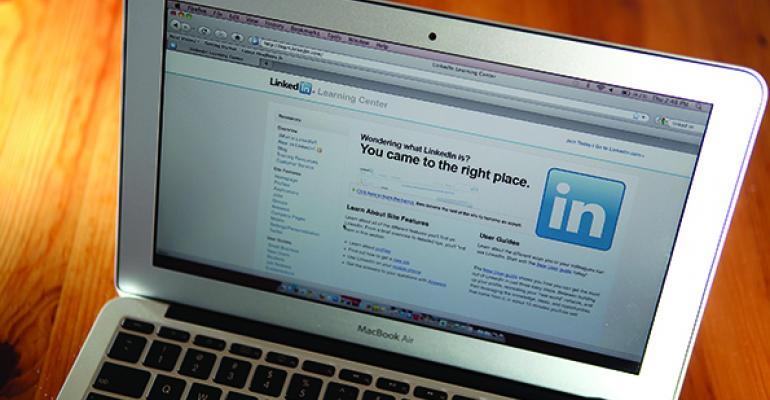The Oechsli Institute’s 2014 Financial Advisor Social Media research found that LinkedIn is a powerful marketing tool when a personal introduction isn’t possible.
The following is an excerpt from The Indispensable LinkedIn Sales Guide for Financial Advisors that I co-authored with Kevin Nichols:
While you may not be reaching out to someone cold on a daily basis, there are always times when an introduction isn’t feasible. If you stumble upon a prospect outside of your reach, don’t be afraid to make use of the tips below. This is also the kind of work an intern can handle, with a little guidance.
Also, financial advisors with a limited network or a highly defined niche could benefit from implementing such an approach.
The Process
Cold prospecting on LinkedIn is a numbers game. Achieving success will take multiple contacts and an array of tactics. Here is the process we coach advisors through when executing a cold strategy.

Step 1: Build a List of Prospects
The first step of your LinkedIn cold-prospecting campaign is to build a list of prospects. Include people who:
- Would be ideal prospects
- Share multiple commonalities with you (same university, interests, volunteer experience, etc.)
- Share multiple connections with you
All of these qualifications don’t have to be met, but the more you have the more you increase the likelihood of making a connection. With your list in hand, you are ready to craft your message.
Step 2: Craft Your Message
Write a killer subject line. The first thing your prospect will see is your subject line. It helps them decide whether to continue reading or ignore the message entirely. Here are some subject lines we like:
Enjoyed your recent article on [insert topic]
Resource for Caterpillar executives
Fellow UNC alumni – Mutual connection of Jane Doe
Acknowledge the cold approach. Start your message by letting your prospect know you’ve never spoken to them before. While this might seem obvious, it puts the cold nature of the contact front and center. Acknowledging this will help break the ice and position you as an honest person.
Make it about them — not you. If your message sounds like it’s all about how great you are and what’s in it for you, you’ve missed the mark. Make sure to include at least one or two sentences that demonstrate why it would be valuable for the prospect to speak with you.
Less is more. You are basically interrupting someone when sending them a message. So keep your interruption short and sweet. No one wants to read a dissertation.
Have one clear call to action. Be clear about the next step you are requesting. Don’t include multiple calls-to-action in your message. Here is a good example:
Would you mind if I gave you a quick call this week? I would really appreciate it.
Step 3: Make Contact
With your message in hand, you are ready to make contact. There are multiple media you can leverage to make contact with your prospects. We recommend a combination of the following, as they are not mutually exclusive:
Cold Connect: This method involves sending a cold invitation to connect on LinkedIn first. Once your prospect accepts your invitation to connect, you can send them a direct message through LinkedIn.
InMails: InMails are messages to LinkedIn users who are outside of your network. This is one of the reasons you need a premium (paid) version of LinkedIn.
Emails: This tactic will require you to discover your prospect’s email address.
Step 4: Follow-up
If you don’t get a response to your first message, send another. We’ve found that many advisors who do this get a better response rate the second, third, or fourth time around. After five to seven days, send a similar message as a follow-up to your initial one. In this message, acknowledge that you have tried to contact them in the past, and get specific with your call to action.
The book’s expected release is early December. You can follow Matt Oechsli on Twitter @MattOechsli for release updates.






